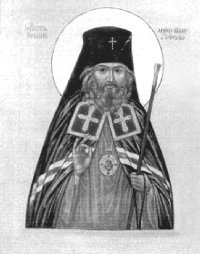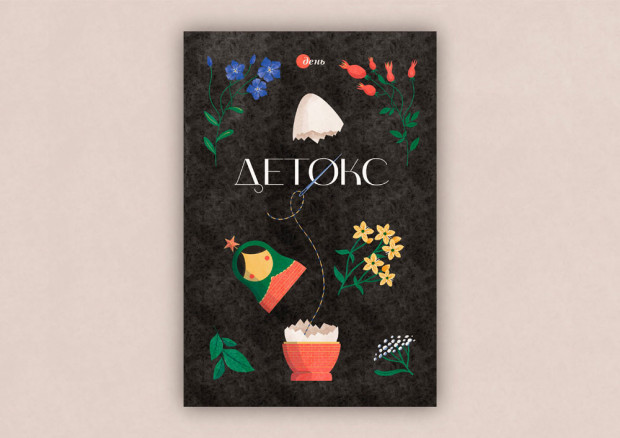St. Ioann (Maksymovych)The Miracle-Worker

There are unusual life stories about remarkable families. The Maksymovyches formed an ancient aristocratic dynasty sired by Maksym Vasylkivsky. Among its most celebrated representatives were Metropolitan Ioann of Tobolsk and Siberia (1651-1714), who converted thousands of pagans and left a sizable literary heritage and Mykhailo Oleksandrovych (1804-73), Rector of St. Volodymyr University (now Kyiv Shevchenko National University), a Ukrainian educator who published an almanac contributed to by Pushkin, Baratynsky, and Delvig.
The Maksymovyches gave the twentieth century one of its most captivating personalities, Archbishop Ioann of Shanghai and San Francisco (1896-1966).
Immediately after his death he started being eulogized as a saint in Eastern Orthodox churches abroad. His life story was published in Holland in 1966. There is a long list of English language editions dedicated to him, and even a divine service. His name is respected in the United States, France, and Latin America.
A great many people knew him, often meeting him by sheer chance, and each and everyone (Catholics included) became aware of his saintliness. There were enemies, of course, enough and to spare. They did their utmost to make his life miserable. Seraphim Rose, US Orthodox Hieromonk (an Orthodox monk who is also a priest) and writer, said that these people could not put up with living saintliness.
The future archbishop was born in Adamivka, a village in Kharkiv gubernia, and was baptized and named after the Archangel Michael. In 1914, he graduated from Poltava's military school and in 1918 (before the Soviets came) from the Law Department of Kharkiv University. In 1921, in the heat of the fratricidal civil war, his family immigrated to Belgrade where he graduated from theological college. In 1926, Metropolitan Antony admitted him to monastic vows. Until 1934, Hieromonk Ioann (Old Church Slavonic for Ivan) was first a teacher in a Serbian institution of higher education and later in a seminary. Even then one could often hear, "If you want to see a living saint, visit Father Ioann." In 1934, he was ordained bishop and sent to the Shanghai diocese.
In Shanghai, he found a huge unfinished cathedral and a conflict flaring between the jurisdictions. He started by restoring Church unity. His flock, hapless Soviet refugees, soon discovered that the bishop was unbelievably ascetic. He would eat once every 24 hours and never slept in bed. He organized several benevolent associations for refugees and an orphanage that would provide food and shelter to a total of 3,500 homeless children. Almost daily he visited local hospitals and prisons. He often walked Shanghai streets at night even under the Japanese curfew which was amazing.
Once he was called to give Communion to a woman who was dying bitten by a rabid dog. During the rite she had another attack and started foaming at the mouth. She spat out the Eucharist. Bishop Ioann picked it up, swallowed it, and told the horrified relatives, "Don't worry. Nothing will happen to me. It's the Eucharist."
His admirers collected and recorded dozens of miracles he had worked, among them cases that cannot be explained materially.
He conducted Liturgies not only in the "eternal" languages, but also in all basic European tongues, including Serbian, and used Chinese while in Shanghai.
V-E Day made some of the ОmigrОs euphoric. They started sending letters of repentance addressed to the "leader of the peoples", Joseph Stalin, congratulating him on the victory, and many returned to the USSR. Some were hanged right then and there (like Ataman Semenov), others found themselves before a firing squad or behind barbed wire. Bishop Ioann was pressed hard to recognize the Moscow Patriarch's jurisdiction, but the Patriarch was not in a position to help even his relatives. He was pressured, and then they tried to poison him. Finally a ukase appeared ordering his suspension, as though he had committed a grave infraction of Canon Law. However, the Rt. Rev. Ioann had sworn allegiance to the Orthodox Church abroad. Moreover, he saw that Soviet power could not be trusted, so his reply read: "I will abide by this ukase only when they prove to me, using the Scriptures and laws of any country, that oath-breaking is a virtue and allegiance a sin."
The Communists came to power in China. None of the "most democratic and humanistic" countries wanted to admit five thousand refugees, the flock of Archbishop Ioann of Shanghai. Had it not been for his tireless care, how many of these would have wound up in prison camps or in front of firing squads? No one has calculated or ever will.
After complicated negotiations, the Archbishop was allowed to settle with his charges on Tubabao, an island in the Philippines. The name was hard to pronounce and sounded exotic. And the reality matched the name.
Perhaps many things can be explained materialistically. As chance occurrences, among other things. All right. A fact: for 27 months on end this island was bypassed by typhoons, although the place was smack on their age-old seasonal route. And there are more than one season in the year. What was it? A coincidence? Maybe. The five thousand making up the congregation knew that Archbishop Ioann sprinkled holy water over their settlement every night. In two years only once did a typhoon approach the island and at the very last moment turned aside and it looked very strange. Once the refugees left the island it was caught in a typhoon and all their barracks vanished.
Then it was Paris. The local aristocracy was flabbergasted: the newly appointed archbishop was walking around barefooted. Complaints were filed and he ordered to use footwear. He obliged and started carrying a pair of shoes in his hands. Then he was sent to Brussels and later to San Francisco where he built another church, destined to be the place of his last repose.
And then his time came and he gave up the ghost, but his body turned out immune to decomposition. It was in the middle of the summer, and it was a fact witnessed by everybody, including the funeral home officials and the Supervisory Council who resolved unanimously to allow the body to be interned in an "unauthorized" place.
People report miracles worked after addressing prayers to Archbishop Ioann, including recent cases of surviving in a plane with both engines on fire and a full recovery from AIDS.
They say that the five-cupola cathedral dedicated to the miracle-working
icon of the Mother of God "For Joy to All Who Sorrowful" is seen from many
points in San Francisco, from the ocean, and when standing on the Golden
Gate Bridge... Now it can be glimpsed from the Dnipro in Ukraine as an
icon portraying St. Ioann appeared in a monastery near Cherkasy. This author
saw it.
Newspaper output №:
№39, (1998)Section
Culture





